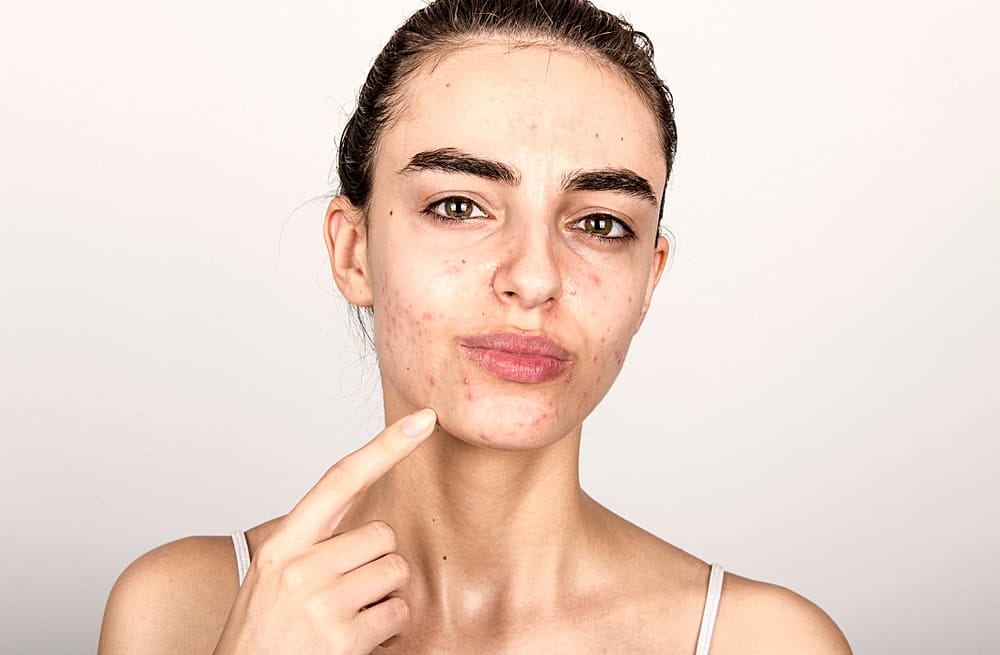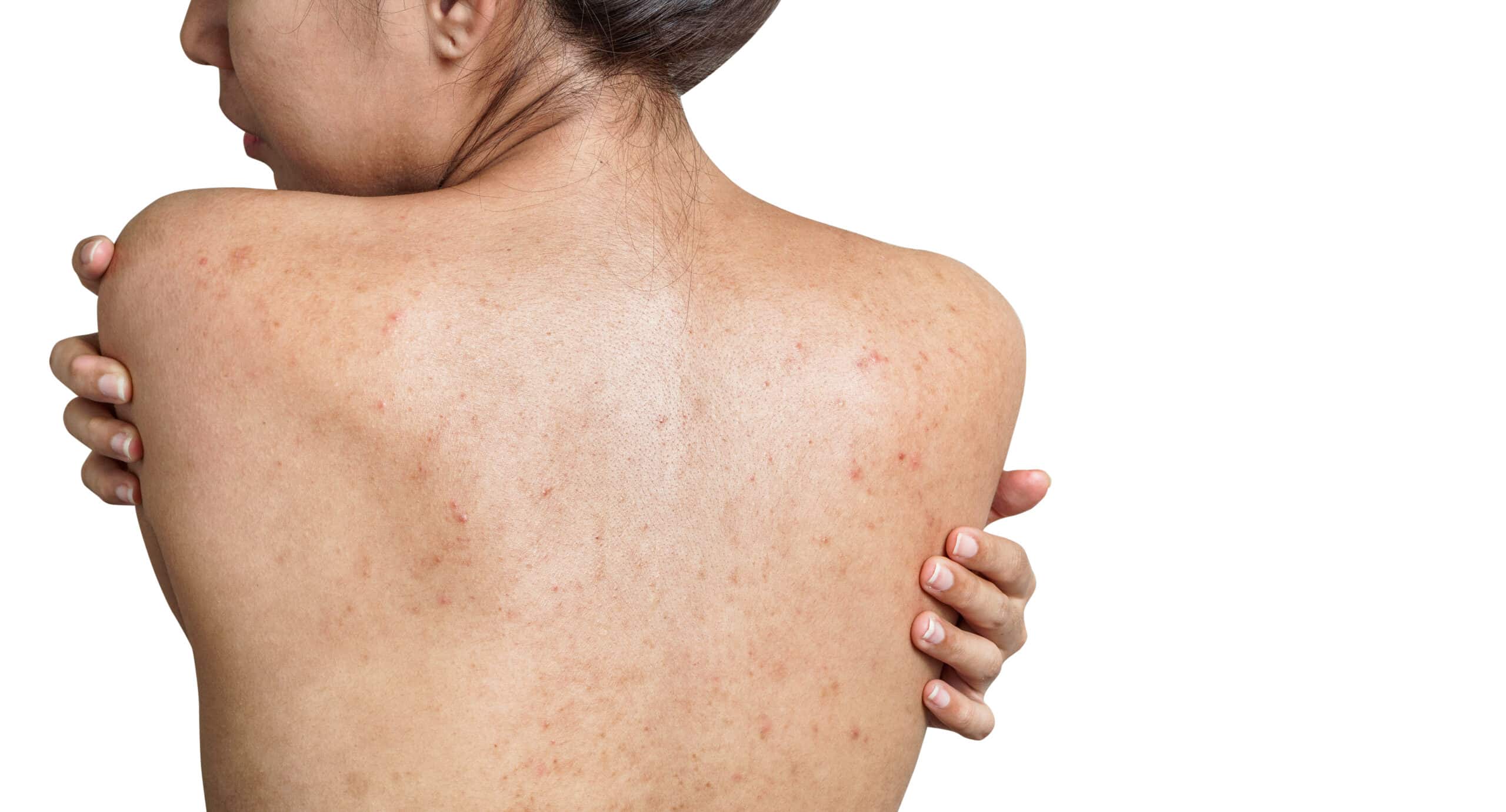
What Causes Truncal Acne And How Can It Be Treated?
- November 22, 2022


Acne is commonly associated with adolescence, but for many people, it is an issue that persists even in adulthood. Truncal acne, or bacne, is a common but neglected type of acne that appears on the back, chest and shoulders, and can be particularly challenging to treat.
Over 50% of patients with acne have truncal acne. Those who have truncal acne are often self-conscious and embarrassed about their skin. They may limit their clothing choices, opting for outfits that conceal their blemished skin.
Fortunately, there is hope for people struggling with truncal acne. Understanding the causes of bacne and treatment options can help you get clearer skin and improve your confidence.
Bacne shares many of the same causes as facial acne. However, bacne tends to be more stubborn and persistent than facial acne. Truncal acne can be particularly difficult to treat because the skin on the back is thicker and has larger sebaceous glands than the skin on the face.
Understanding the underlying causes of truncal acne is the first step in creating a successful treatment plan. By addressing these underlying factors, you can reduce the frequency and severity of breakouts and achieve clearer and smoother skin that you can feel confident showing off.
Hormones are responsible for many functions in the body, including the production of sebum in the skin. Excess sebum produced from hormonal imbalances can lead to bacne breakouts. These hormonal imbalances can be triggered by:
During puberty, the body undergoes a surge in androgen hormones, such as testosterone, which can trigger the overproduction of sebum. Excess sebum can lead to clogged pores and the formation of acne lesions on the back and other parts of the body.
Hormonal changes during the menstrual cycle or pregnancy can also cause bacne flare-ups as oestrogen and progesterone levels fluctuate. In particular, pregnant women experience an increase in androgens.
Hormonal disorders such as polycystic ovary syndrome (PCOS) can cause back and other body acne. PCOS is characterised by an imbalance of reproductive hormones, particularly an increase in androgens such as testosterone.
Oral contraceptives, also known as birth control pills, contain hormones that prevent ovulation and pregnancy. There are various types of oral contraceptives; some are used to treat acne, and some actually worsen acne! Using the right type of oral contraceptives can help control acne and bacne.
Certain medications can cause hormonal imbalances by interfering with the regulation of the endocrine system. The endocrine system is responsible for producing and regulating hormones in the body.
One study shows that the likelihood of developing bacne can be inherited, and certain genes can increase an individual’s susceptibility to truncal acne. These genes include those involved in:
In addition, certain genetic traits, such as having naturally oily skin and large pores, increase your risk of developing bacne.
Propionibacterium acnes (P. acnes) is a bacteria that naturally lives on the skin and is associated with developing acne lesions. When excess sebum and dead skin cells clog the pores on the back, P. acnes can colonise the blocked pores and multiply, leading to inflammation and infection.
Sweat and friction can contribute to the development of truncal acne by creating a warm, moist environment conducive to bacterial growth. When mixed with bacteria, sebum, and dead skin cells on the skin’s surface, sweat can clog pores and trigger inflammation. Friction can further aggravate the skin and contribute to the development of bacne lesions.
Poor hygiene practices can lead to the accumulation of dead skin cells and sebum. When these substances mix, they can clog pores and hair follicles, forming bacne lesions.
Poor hygiene practices include:
Not Showering Regularly
Failing to shower regularly can allow oil, sweat, and dirt to accumulate on the skin’s surface, providing a breeding ground for bacteria.
Wearing Dirty Clothes
Wearing clothing that has not been washed can introduce bacteria and dirt onto the skin’s surface.
Using Dirty Towels and Bedding
Using towels and bedding that have not been washed can also introduce bacteria onto your skin’s surface.
Not Exfoliating Regularly
By exfoliating appropriately, we can remove dead skin cells that accumulate and cause bacne.
One study suggests that consuming high-glycemic-index foods such as bread, pasta, and sugary drinks may worsen bacne.
There are many ways to treat, manage, and stop the growth of truncal acne, ranging from topical treatments to oral drugs. Let’s look at some of the commonly recommended truncal acne solutions in Singapore.
Patients often turn to topical treatments for their first defence against bacne. These treatments are applied directly to the skin and come in the form of creams, gels, and lotions. They include:
Benzoyl peroxide kills bacteria on the skin’s surface and unclogs pores. Once absorbed, benzoyl peroxide releases oxygen, which helps kill the bacteria that leads to acne breakouts. It also helps to dry out excess oil and remove dead skin cells, which can contribute to bacne.
In addition to its antibacterial and exfoliating properties, benzoyl peroxide has anti-inflammatory effects. It can help to reduce the redness and swelling associated with bacne, making it a useful treatment for both mild and moderate forms of truncal acne.
Salicylic acid is oil-soluble and can penetrate the pores and break down the oil and dead skin cells that cause acne. By removing this buildup, salicylic acid can help to prevent new bacne breakouts and reduce the appearance of existing acne.
Retinoids increase cell turnover, which can prevent the buildup of dead skin cells, unclog pores and ease inflammation. Retinoids have a good reputation for acne treatment but there aren’t many formulated specifically for truncal acne. One exception is trifarotene. In a 52-week phase III trial, it was found that success rates for truncal acne were 66.9%.
Trifarotene effectively treats bacne by penetrating the thicker skin on the back, helping to reduce the formation of acne lesions.
Trifarotene is effective in reducing both inflammatory and non-inflammatory lesions associated with bacne. One available brand of trifarotene is Aklief, which is especially suitable for teenagers undergoing puberty.
Oral medications can be useful in treating moderate to severe cases of bacne. Here are some common ones.
Antibiotics work by reducing inflammation and killing the bacteria that contribute to acne. Medications like tetracycline, doxycycline, and minocycline are often used with topical treatments to treat back acne.
Another option is hormonal therapy, which can be effective for women dealing with bacne caused by hormonal imbalances. Hormonal therapy regulates hormone levels in the body, particularly androgen hormones. Androgens increase sebum production, leading to clogged pores, and the growth of bacne-causing bacteria.
Several types of hormonal therapy can be used to treat bacne, including birth control pills and anti-androgen medications. Birth control pills that contain oestrogen and progesterone, can help to regulate androgen levels and reduce the severity of bacne. Anti-androgen medications work by blocking the effects of androgens in the body, reducing sebum production and acne development.
isotretinoin, is often used for cases of severe bacne, or for cases that are not responding satisfactorily to other treatments. It works by regulating skin turnover and reducing the size of the oil glands in the skin.
In Singapore, isotretinoin is only available with a doctor’s prescription
Laser therapy is another treatment option for truncal acne. This non-invasive procedure uses focused beams of light to penetrate the skin. The laser targets the bacteria and oil that lead to breakouts. This laser energy can also stimulate collagen production, helping to refine the texture and appearance of the skin.
Laser therapy is particularly effective for treating severe or persistent bacne. It can target specific body areas, such as the back, chest, or shoulders, where truncal acne is most common.
Chemical peels are non-invasive procedures that use chemical solutions to exfoliate the skin, removing dead skin cells and unclogging pores to prevent future breakouts. Chemical peels can be tailored to your skin type and bacne severity, making them a highly effective treatment option for truncal acne.
Chemical peels work by applying glycolic acid, salicylic acid, or another active ingredient to the skin. This solution disintegrates dead skin cells, allowing them to be gently removed from the skin’s surface. The process also stimulates the production of collagen, which can help smooth the appearance of the skin.
Ethosome Gold Photothermal therapy, or Gold PTT, uses a combination of gold nanoparticles and active ingredients with light and heat energy to destroy acne-causing bacteria and reduce inflammation in the skin.
The Ethosome Gold PTT is first applied to the skin where it is absorbed into the pilosebaceous units. A laser treatment is then performed to destroy the pilosebaceous units without causing collateral damage to the surrounding skin. At the same time, the gold nanoparticles provide an anti-inflammatory effect that promotes healing.
If you are experiencing back acne that is causing you discomfort or interfering with your daily life, it may be a good idea to consult a doctor. A doctor specialising in skin conditions can help diagnose and treat your bacne. They may recommend topical or oral medications, lifestyle changes, or other treatments to help clear up your bacne and prevent future breakouts.
Some forms of truncal acne can be a sign of an underlying medical condition, such as hormonal imbalances or infections, so it is always good to seek professional help if you have concerns about your bacne.
At SL Aesthetic Clinic, we recommend a comprehensive bacne treatment plan to target the various causes of bacne. This treatment plan may include laser therapy, topical and oral medications, and chemical peels.
Our doctors in Singapore are skilled at using multiple modalities to treat patients’ specific conditions and tailor their treatments for the best results. Book a consultation today to learn more about your truncal acne and how we can help.
Like what you read? Share them!